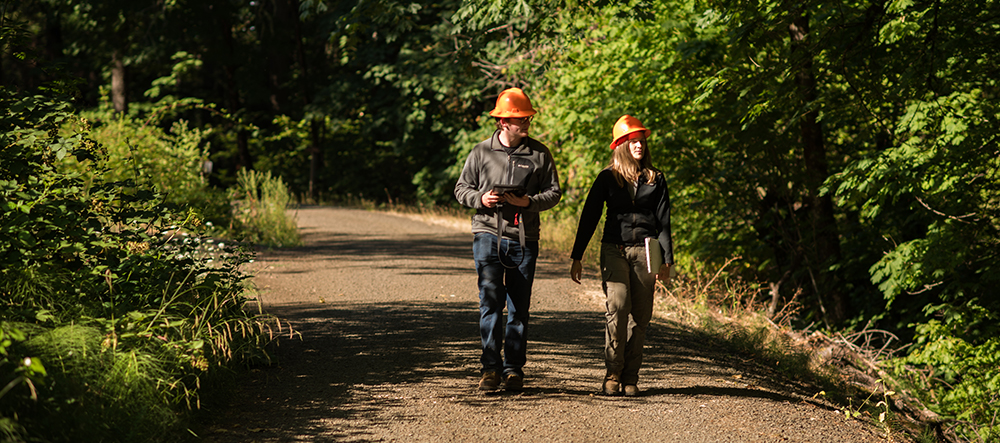The OSU College of Forestry Research Forests Offers Many Opportunities to the OSU and Corvallis Communities

With over 155,000 visits a year, the McDonald and Dunn Research Forests are well known for the many recreational opportunities in the forests – from dog walking to trail running to horseback riding, thousands of people frequent the McDonald and Dunn Forests to enjoy the outdoors.
But, the McDonald and Dunn Forests are much more than a network of popular trails and forest roads. They join eight other forests across Oregon that collectively make up OSU’s College of Forestry’s Research Forests – which are all utilized for many different functions in addition to recreation, including public outreach, education and research.
“The OSU Research Forests offer many valuable outdoor learning opportunities,” said Holly Ober, associate dean for science outreach and professor in the department of forest ecosystems and society.
“Students can visit the woods on field trips to see and experience examples of topics covered in textbooks and lectures. Researchers can implement experiments that help increase understanding of issues of contemporary concern. Outreach specialists can host workshops that showcase demonstrations for woodland owners and professional forest managers. Visitors of all ages can take self-guided tours. And local community members benefit from opportunities to recreate and relax in nature.”
As their names suggest, one of the primary functions of the Research Forests is to serve as an outdoor laboratory for researchers. The forests have hosted projects that span many disciplines and much of the research considers how to actively and sustainably manage forests while addressing economic, social, and environmental factors. The hope is for the Research Forests to help advance the field of forestry through scientific inquiry.
“We don’t want the forests to be focused on any single issue,” said Stephen Fitzgerald, director of College of Forestry research forests and professor of forest engineering and resources and management. “We want to explore the many different elements of sustainable forest management, including how managing forests affect carbon, wildlife, timber production, and water yield.”
Various research projects across the 15,000 acres of Research Forests have examined wildlife and wildlife habitat, carbon sequestration, forest resiliency amidst climate change, invasive species, recreation, biodiversity conservation, timber production, economic prosperity, ecosystem processes, and forest sustainability. Researchers have utilized the forests for this work for nearly a century.
A current research project, led by Cat Carlisle who is pursuing a graduate degree in the department of forest, engineering and resource management, is looking at the potential for Oregon’s forests to contribute to carbon storage and sequestration. Carlisle is analyzing the inventory of carbon stock in the McDonald and Dunn Forests – and projecting how different forestry management strategies might shift carbon levels in the forests over the next 150 years. This project will provide decision-makers with valuable information about how to optimize forest management to help mitigate climate change.
“A lot of the focus in forestry right now is on identifying which forest management strategies will enhance forest carbon,” Carlisle explained. “The hope is to find ways to use forest management to take carbon dioxide out of the atmosphere and sequester it in biomass, to contribute to climate change mitigation. I hope this project sheds light on how to manage a sustainable working forest in a way that considers ecological factors like carbon stock, especially as the climate changes.”
Because Carlisle is conducting this work in the Research Forests, she was able to immediately jump in and access a wealth of data that’s been collected over the years.
The Research Forests also serve as an outdoor classroom for students at Oregon State University – for classes offered through the College of Forestry and through other departments across Oregon State. Students are able to get a hands-on education and develop skills in subjects like silviculture, soils, wildlife, recreation management, prescribed fire, and ecology through the forests.
“We are fortunate to have these Research Forests located right here in Corvallis,” said Ober. “The close proximity to campus makes it possible for students to take field trips to the woods during scheduled lab periods, and allows both students and faculty to conduct outdoor research without extensive travel expenses.”
The forests also host a robust public outreach program and recreational opportunities. The McDonald and Dunn Forests contain 30 miles of trails and 110 miles of roads that are open for non-motorized use and enjoyment so the local community can explore the outdoors and enjoy nature. The many activities available in the forests include hiking, dog walking, horseback riding, hunting (only allowed on Dunn Forest), trail running, picnicking, bird watching, and mountain biking. This all happens alongside educational programs that allow people to learn more about the Research Forests through self-guided tours, the Forest Discovery Trail, interpretive signs, and community events like Get Outdoors Day and seasonal guided forest walks.


Good article. There are a couple of other public benefits derived from the OSURF.
1. Provide emergency evacuation routes for residents living in the Urban Wildland Interface
2. Provide trails for local cross country athletes. There are two local high school
runners who train in the forest that are Oregon state champions.